Kina sigter mod at bygge sin egen Yellowstone på det tibetanske plateau

Toppe når mod himlen i Angsai, et område inde i Sanjiangyuan -regionen i det vestlige Kinas Qinghai -provins søndag, 25. august, 2019. Omgivet af verdens højeste bjergkæder, regionen længe kendt som "verdens tagterrasse" er nu i trådkorset i Kinas seneste moderniseringsfremstød. Men denne gang, den kinesiske regering ønsker at sætte grænser for regionens vækst for at implementere sin egen version af en af USA's stolteste arv – et nationalparksystem. (AP Photo/Ng Han Guan)
Der er et byggeboom på det tibetanske plateau, et af verdens sidste fjerntliggende steder. Bjerge, der længe er kronet af guirlander af blafrende bedeflag - en traditionel landskabsvelsignelse - er for nyligt toppet med vidtstrakte stålledninger. Om natten, de oplyste skilte på Sinopec tankstationer kaster et rødt skær over nybyggede motorveje.
Omgivet af verdens højeste bjergkæder, regionen længe kendt som "verdens tagterrasse" er nu i trådkorset for Kinas seneste moderniseringsfremstød, præget af mange skyskrabere og udvidelse af højhastighedstogstrækninger.
Men denne gang, der er en forskel:Den kinesiske regering ønsker også at sætte grænser for regionens vækst for at designe sin egen version af en af USA's stolteste arv – et nationalparksystem.
I august, politikere og videnskabsmænd fra Kina, USA og andre lande mødtes i Xining, hovedstaden i landets Qinghai-provins, at diskutere Kinas planer om at skabe et samlet parksystem med klare standarder for begrænsning af udvikling og beskyttelse af økosystemer.
Landets økonomi har boomet i løbet af de sidste 40 år, men prioriteterne udvides nu til at omfatte bevarelse af vigtige naturressourcer, siger Zhu Chunquan, Kinas repræsentant for International Union for the Conservation of Nature, en schweizisk-baseret videnskabelig gruppe.
”Det er ganske presserende så hurtigt som muligt at identificere stederne, økosystemerne og andre naturlige træk" for at beskytte, siger Zhu.

En tibetansk kvinde passer et barn i Angsai, et område inde i Sanjiangyuan-regionen i det vestlige Kinas Qinghai-provins søndag, 25. august, 2019. Et nøglespørgsmål rejser sig over landets nationalparkprojekt:Kan Kina forene målene om bevaring og turisme, samtidig med at man sikrer levebrødet og kulturen i de cirka 128, 000 mennesker, der bor inden for eller nær parkens grænser, mange af dem tibetanske? (AP Photo/Ng Han Guan)
Blandt andre mål Kina sigter mod at bygge sin egen Yellowstone på det tibetanske plateau.
Zhu tjener i et rådgivende udvalg, der giver input til udviklingen af Kinas begyndende nationalparksystem, forventes officielt at blive afsløret i 2020. Kinesiske embedsmænd har også besøgt amerikanske nationalparker, herunder Yellowstone og Yosemite, og søgte input fra forskellige organisationer, herunder det Chicago-baserede Paulson Institute og Nature Conservancy.
Ambitionen om at skabe et samlet parksystem repræsenterer "en ny og seriøs indsats for at beskytte Kinas biodiversitet og naturarv, "Duke University økolog Stuart Pimm siger.
En af de første pilotparker vil være i Qinghai, en stor region i det vestlige Kina, der støder op til Tibet og deler meget af dets kulturelle arv. Området er også hjemsted for sådanne ikoniske og truede arter som sne -leoparden og kinesisk bjergkat, og omfatter udløbet af tre af Asiens store vandveje:Yangtze, Gule og Mekong-floder.

Skyer svæver over det bjergrige landskab i Angsai, et område inde i Sanjiangyuan-regionen i det vestlige Kinas Qinghai-provins søndag, 25. august, 2019. Kina sigter mod at bygge sin egen Yellowstone på det tibetanske plateau. (AP Photo/Ng Han Guan)
"Dette er en af de mest specielle regioner i Kina, i verden, " siger Lu Zhi, en bevaringsbiolog fra Peking University, som har arbejdet i Qinghai i to årtier.
Mens byggeriet fortsætter i et rasende tempo andre steder på det tibetanske plateau, regeringen er allerede holdt op med at udstede minedrifts- og vandkrafttilladelser i denne region.
Men et nøglespørgsmål rejser sig over projektet:Kan Kina forene målene om bevaring og turisme, samtidig med at de omkring 128 levebrød og kultur sikres, 000 mennesker, der bor inden for eller nær parkens grænser, mange af dem tibetanske?
"Kina har en tæt befolkning og en lang historie, " siger Zhu. "Et af de unikke træk ved Kinas nationalparker er, at de har lokale mennesker, der bor enten inde i eller i nærheden."
Yellowstone er almindeligt betragtet som verdens første nationalpark. Efter det blev oprettet i 1872, den amerikanske regering tvang de indfødte amerikanere, der boede i området, til at genbosætte sig uden for parkens grænser, i overensstemmelse med 1800-tallets forestilling om, at vildmarksbeskyttelse betød natur adskilt fra mennesker. Men lande, der forsøger at etablere parksystemer i det 21. århundrede, må nu overveje, hvordan de bedst kan inkludere lokale befolkninger i deres planlægning.

Tibetanske kvinder malker deres yaks i Angsai, et område inde i Sanjiangyuan-regionen i det vestlige Kinas Qinghai-provins søndag, 25. august, 2019. Qinghai er en stor region i det vestlige Kina, der støder op til Tibet og deler meget af sin kulturelle arv. (AP Photo/Ng Han Guan)
"At finde ud af, hvordan man opnår økologisk bevaring og støtte til samfundene på samme tid - det er den mest komplicerede gnidning, du har, " siger Jonathan Jarvis, en tidligere direktør ved U.S.National Park Service og nu professor ved University of California, Berkeley, som har turneret i Qinghai pilotpark, kaldet Sanjiangyuan.
Kina har tidligere gennemført omfattende genbosættelsesprogrammer for at rydde jord til store infrastrukturprojekter, såsom Three Gorges Dam og South-to-North Water Transfer Project. Disse genbosættelser efterlod mange landmænd i nye hjem uden egnede landbrugsmarker eller adgang til andre levebrød.
Men i udviklingen af nationalparkerne, the government is giving conservation-related jobs to at least a swath of people living in Sanjiangyuan to stay and work on their land. The "One Family, One Ranger" program hires one person per family for 1800 yuan a month ($255) to perform such tasks as collecting trash and monitoring for poaching or illegal grazing activity.
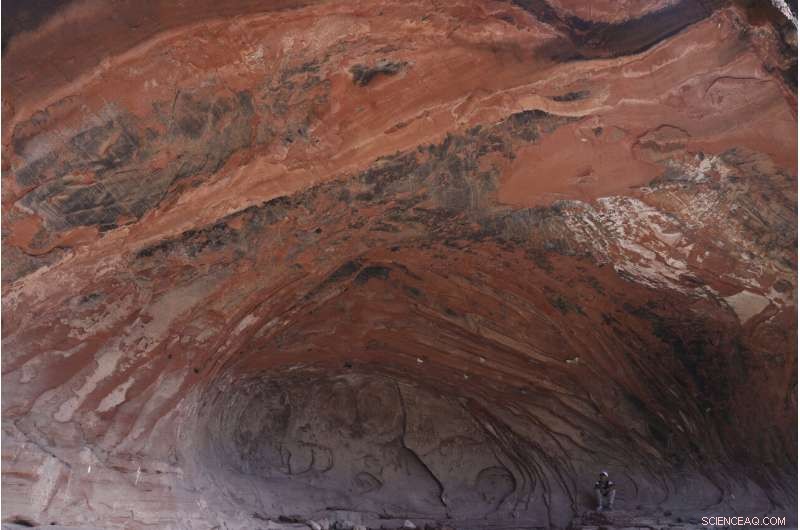
A Tibetan youth sits at the base of a natural cave formation in Angsai, an area inside the Sanjiangyuan region in western China's Qinghai province on Sunday, Aug. 25, 2019. China has previously undertaken vast resettlement programs to clear land for large infrastructure projects, but in developing the national parks, the government is giving conservation-related jobs to at least a swath of people living in Sanjiangyuan to stay and work on their land. (AP Photo/Ng Han Guan)
It's difficult to interview residents in China's ethnic borderlands like Qinghai, due to restrictions on journalists that make it hard to travel widely or freely in those areas. Regions with large ethnic and religious minorities, including all Tibetan areas, are subject to heightened political and religious controls.
But a few people living in Angsai, a Tibetan village located within the new Qinghai park, were willing to speak, although it's not possible to determine if their experiences are typical.
A-Ta is a Tibetan herder whose income largely comes from raising yaks and collecting caterpillar fungus, a folk medicine taken as a purported aphrodisiac or for respiratory problems. He also leads a team of trash collectors, traveling as much as 34 kilometers (21 miles) a day to comb the hillsides for plastic bottles and other waste as part of the "One Family, One Ranger" program.
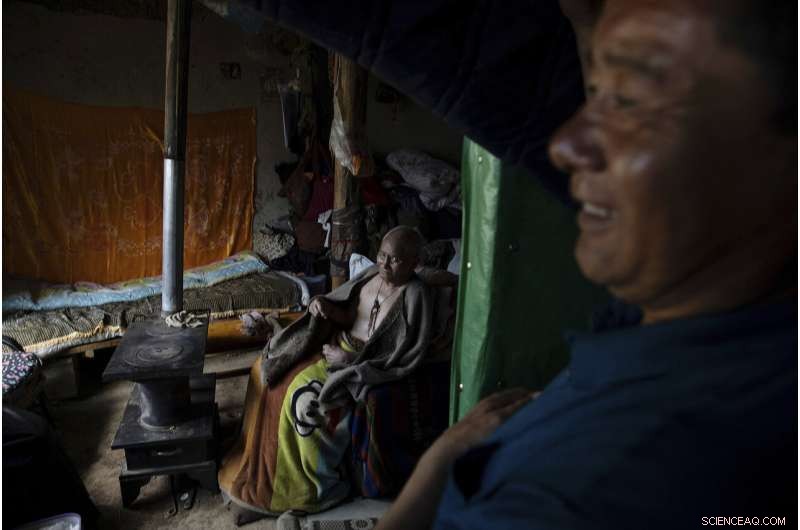
A-Ta, at right stands near his father in their home in Angsai, an area inside the Sanjiangyuan region in western China's Qinghai province on Monday, 26. august, 2019. A-Ta, a Tibetan herder whose income largely comes from raising yaks and collecting caterpillar fungus, also leads a team of trash collectors traveling as much as 34 kilometers (21 miles) a day to comb the hillsides for plastic bottles and other waste, as part of the "One Family, One Ranger" program. (AP Photo/Ng Han Guan)
"I am living in this land, my living is relying on this land, " han siger, as his sister heats a kettle in their modest home. A poster showing the faces of China's past leaders and current Communist Party general secretary, Xi Jinping, hangs on the wall.
A-Ta says he is grateful for work that allows his family to stay on their land, even as people in other parts of Qinghai have had to leave. His own son is employed leading a relocation program for "a huge population of nomads" in Dzarto, a county in southern Qinghai.
"I love this land very much, " he says. "I always motivate and encourage people to protect the environment and contribute to the conservation work."
Kunchok Jangtse is a Tibetan herder who also earns money cleaning up rubbish through the "One Family, One Ranger" program.
He has an additional volunteer position through the Chinese nonprofit Shanshui—the name means "mountain, water"—installing and maintaining motion-activated camera traps, which help scientists monitor endangered species in Qinghai.
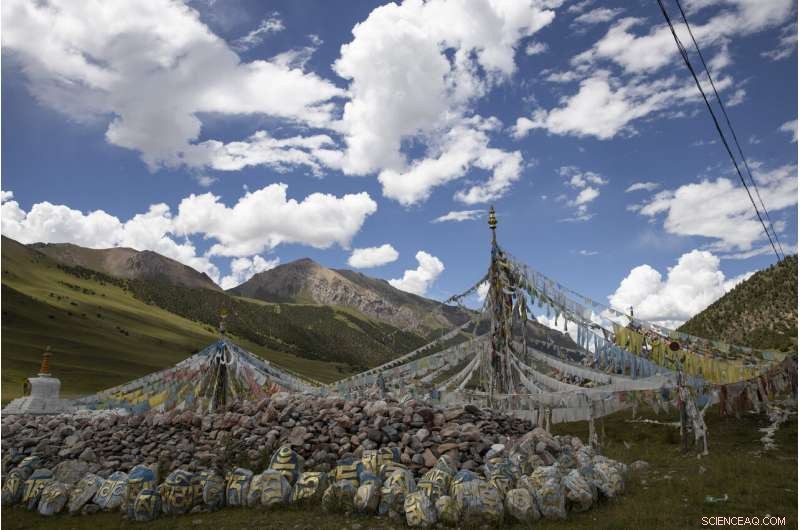
Tibetan prayer flags are seen during a clear day in Angsai, an area inside the Sanjiangyuan region in western China's Qinghai province on Monday, 26. august, 2019. Qinghai is a vast region in western China abutting Tibet and shares much of its cultural legacy. (AP Photo/Ng Han Guan)
As he affixes a camera trap to a thin tree trunk, he explains, "The reason why it has to be installed in this location is because this is the main migration route of the majority of wild animals."
Such camera traps have captured rare footage of snow leopards and Chinese mountain cats, including mothers and their cubs playing near a temporary den.
Kunchok Jangtse says the work of protecting the environment, including reporting illegal poaching activity, is important.
"Our religion is connected with wild animals, because wild animals have a consciousness and can feel love and compassion—therefore, we protect wild-animals, " han siger.
From his main work raising livestock and collecting caterpillar fungus, Kunchok Jangtse says he can make about 20, 000 yuan ($2, 830) a year. He is grateful for the additional income from the ranger program, but mainly hopes his other livelihood won't be impeded—and that he won't eventually be forced to leave.
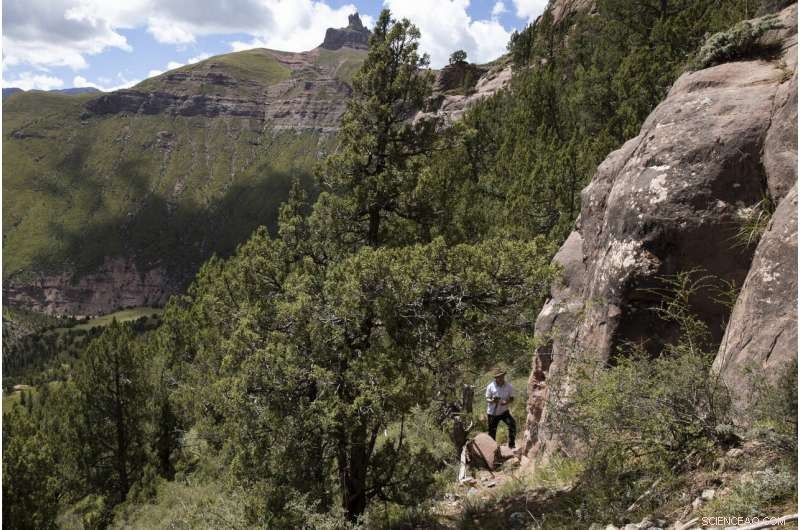
Kunchok Jangtse, a Tibetan herder who also instals and maintains motion-activated cameras, works on a camera in Angsai, an area inside the Sanjiangyuan region in western China's Qinghai province on Tuesday, Aug. 27, 2019. His work helps scientists monitor endangered species. "I'm not a highly educated person, and I am very concerned it may bring many difficulties in my life if I would switch my job and move to another place, " he says. (AP Photo/Ng Han Guan)
"I'm not a highly educated person, and I am very concerned it may bring many difficulties in my life if I would switch my job and move to another place, " han siger.
The question of local people's culture and livelihoods is one of the top concerns that former U.S. National Park Service director Jarvis says China has to wrestle with, along with establishing laws and funding.
"They need a legal framework that defines what a park is, " Jarvis says. "And they need sustainable funding."
The creation of protected areas is not a new idea in China. Faktisk, roughly 15% of the country's land already is assigned to a bewildering patchwork of local and regional parks. But many existing reserves are simply parks on paper, run by various agencies without enforceable guidelines.
I modsætning, the national parks system is being designed from the ground-up to incorporate global best practices and new science.
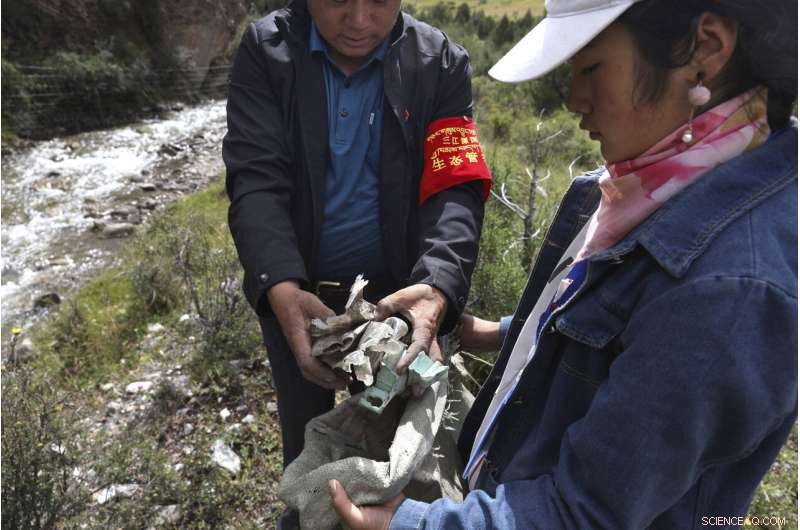
A-Ta, a Tibetan herder whose income largely comes from raising yaks and collecting caterpillar fungus, places refuse in a bag as he leads his team of trash collectors in Angsai, an area inside the Sanjiangyuan region in western China's Qinghai province on Monday, 26. august, 2019. His team travels as much as 34 kilometers (21 miles) a day to comb the hillsides for plastic bottles and other waste, as part of the "One Family, One Ranger" program. "I am living in this land, my living is relying on this land, " he says. (AP Photo/Ng Han Guan)
In his office in Beijing, Ouyang Zhiyun, deputy director at the Chinese Academy of Sciences' Research Center for Eco-Environmental Sciences, pores over hundreds of carefully shaded maps of mainland China that denote priority areas for protecting threatened and endangered species, as well as "eco-system services, " like safeguarding water supplies and limiting soil erosion.
The question isn't just how much total land you're protecting, but which lands you're protecting, he notes.
For nylig, Ouyang was the lead scientist for China's sweeping "national ecosystems assessment, " which used 20, 000 satellite images and 100, 000 field surveys to examine how China's land changed between 2000 and 2010, with some of the findings published in the journal Science in 2016. One resulting statistic:China's urban area increased 28% during that period.
-
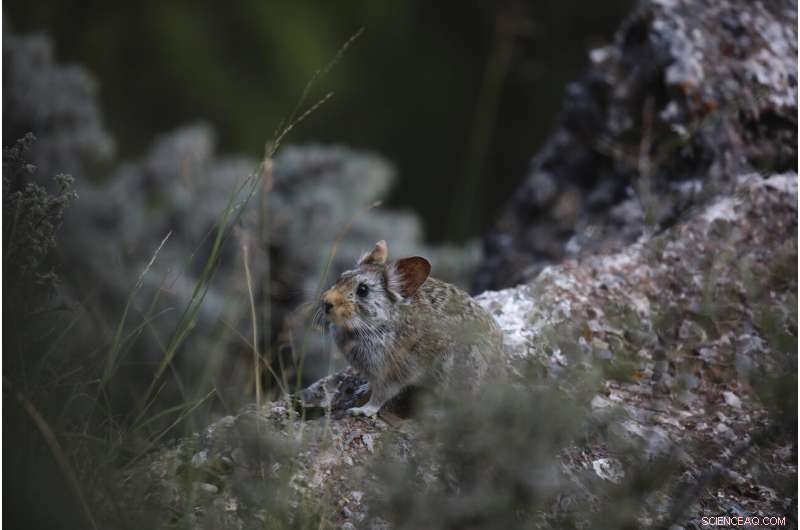
A Glover's Pika surveys its surrounding in Angsai, an area inside the Sanjiangyuan region in western China's Qinghai province on Tuesday, Aug. 27, 2019. (AP Photo/Ng Han Guan)
-
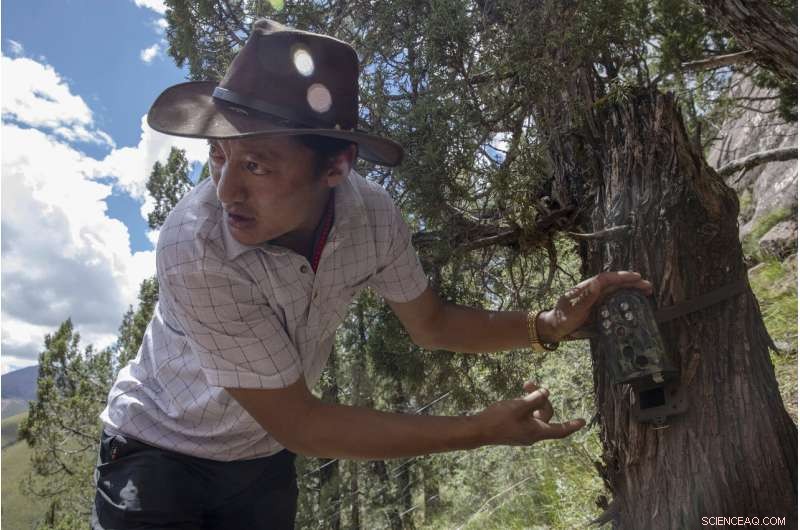
Kunchok Jangtse positions a camera trap in Angsai, an area inside the Sanjiangyuan region in western China's Qinghai province on Tuesday, Aug. 27, 2019. The Tibetan herder also has a job installing and maintaining the motion-activated cameras, which help scientists monitor endangered species in the area. "Our religion is connected with wild animals, because wild animals have a consciousness and can feel love and compassion—therefore, we protect wild-animals, " he says. (AP Photo/Ng Han Guan)
-

The Milky Way glows behind a yak in Angsai, an area inside the Sanjiangyuan region in western China's Qinghai province on Monday, 26. august, 2019. "This is one of the most special regions in China, in the world, " says Lu Zhi, a Peking University conservation biologist who has worked in Qinghai for two decades. (AP Photo/Ng Han Guan)
-

A sunset casts rays of light over the top of a mountain range in Angsai, an area inside the Sanjiangyuan region in western China's Qinghai province on Monday, 26. august, 2019. "This is one of the most special regions in China, in the world, " says Lu Zhi, a Peking University conservation biologist who has worked in Qinghai for two decades. (AP Photo/Ng Han Guan)
-

A bat flies through a narrow crevice in Wuyishan in eastern China's Fujian province on Tuesday, Aug. 13, 2019. (AP Photo/Ng Han Guan)
-

A monkey bares its teeth at visitors in an animal shelter that is part of tourist site in Wuyishan in eastern China's Fujian province on Friday, Aug. 16, 2019. (AP Photo/Ng Han Guan)
-
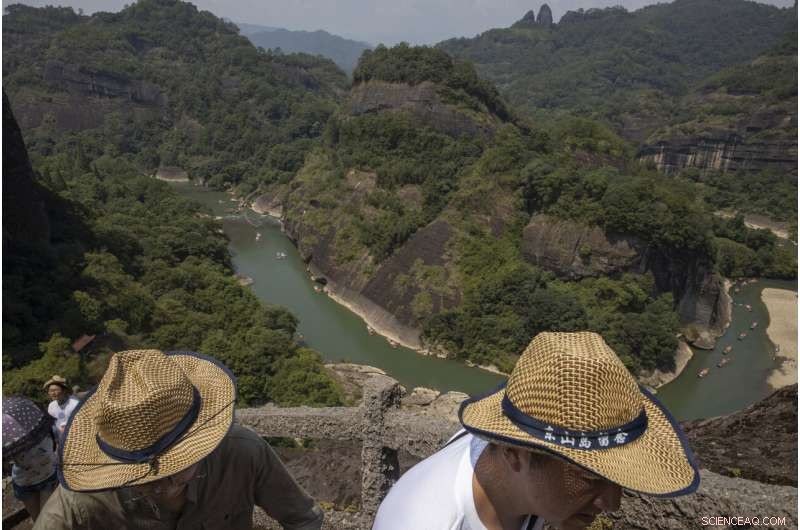
Visitors climb Tianyou peak in Wuyishan in eastern China's Fujian province on Wednesday, Aug. 14, 2019. The ambition to create a unified park system represents "a new and serious effort to safeguard China's biodiversity and natural heritage, " says Duke University ecologist Stuart Pimm. (AP Photo/Ng Han Guan)
-

Women work on a photo for their tea products on a mountain top in Wuyishan in eastern China's Fujian province on Wednesday, Aug. 14, 2019. Zhu Chunquan, the China representative of the International Union for the Conservation of Nature, a Switzerland-based scientific group, notes that the country's economy has boomed over the past 40 years. But priorities are now expanding to include conserving the country's key natural resources. "It's quite urgent, as soon as possible to identify the places, the ecosystems and other natural features" to protect, Zhu says. (AP Photo/Ng Han Guan)
-
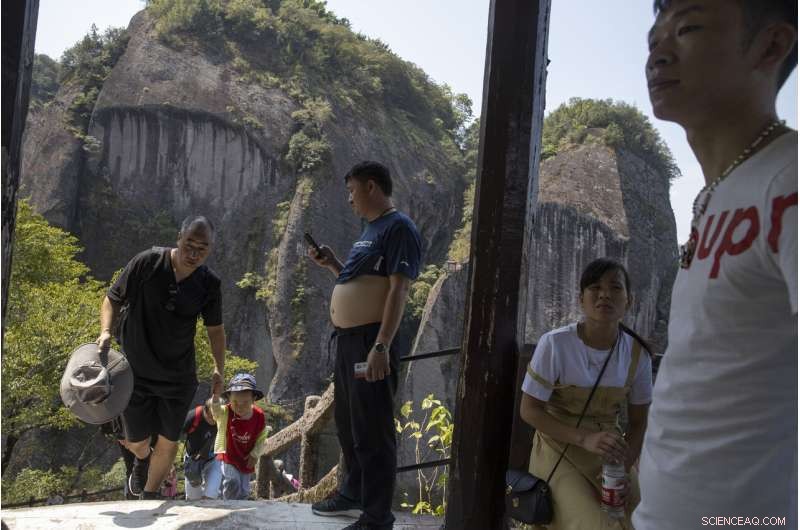
Visitors rest in a pavilion during a climb up Tianyou peak in Wuyishan in eastern China's Fujian province on Wednesday, Aug. 14, 2019. (AP Photo/Ng Han Guan)
-

Visitors climb Tianyou peak in Wuyishan in eastern China's Fujian province on Wednesday, Aug. 14, 2019. (AP Photo/Ng Han Guan)
-
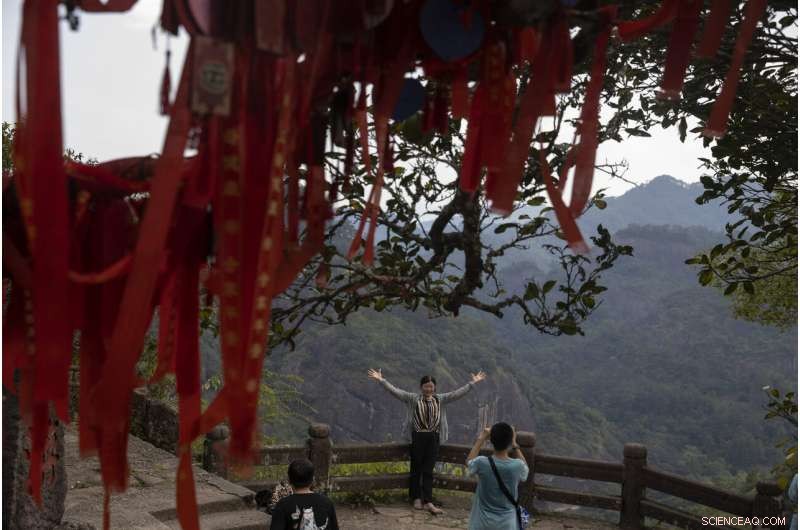
A visitor poses for a photo on Tianyou peak in Wuyishan in eastern China's Fujian province on Wednesday, Aug. 14, 2019. (AP Photo/Ng Han Guan)
-

A woman poses for photos near a waterfall in Wuyishan in eastern China's Fujian province on Thursday, Aug. 15, 2019. (AP Photo/Ng Han Guan)
-

Tourists stand in shallow water along the Nine Bends River in Wuyishan in eastern China's Fujian province on Thursday, Aug. 15, 2019. (AP Photo/Ng Han Guan)
-

Tourists ride in bamboo rafts during a tour of the Nine Bends River in Wuyishan in eastern China's Fujian province on Thursday, Aug. 15, 2019. In August 2019, policymakers and scientists from China, the United States and other countries met in China to discuss the country's plans to create a unified park system with clear standards for limiting development and protecting ecosystems. (AP Photo/Ng Han Guan)
-

A boy holds a water rifle on the banks of the Nine Bends River as bamboo raft operators wait for tourists in Wuyishan in eastern China's Fujian province on Thursday, Aug. 15, 2019. Zhu Chunquan, the China representative of the International Union for the Conservation of Nature, a Switzerland-based scientific group, notes that the country's economy has boomed over the past 40 years. But priorities are now expanding to include conserving the country's key natural resources. "It's quite urgent, as soon as possible to identify the places, the ecosystems and other natural features" to protect, Zhu says. (AP Photo/Ng Han Guan)
Now Ouyang is drawing upon that work, combined with surveys of more than 1, 500 species of endangered and threatened plants and animals, to map priority areas for conservation and advise park planners. He is focusing on habitats of endangered species that live only in China.
"If we lose it here, det er væk, " han siger.
The first parks to be formally incorporated into China's national park system will showcase the country's vast and varied landscapes and ecosystems—from the granite and sandstone cliffs of Wuyishan in eastern China to the lush forests of southwestern Sichuan province, home to giant pandas, to the boreal forests of northeastern China, where endangered Siberian tigers roam.
When it comes to ecology, few countries have more to lose, or to save, than China.
"A huge country like China literally determines the fate of species, " says Duke University's Pimm.
© 2019 The Associated Press. Alle rettigheder forbeholdes.
Sidste artikelSkal Irland brænde sine kraftværker med træ afsendt fra Australien?
Næste artikelRedder liv med renere luft
 Varme artikler
Varme artikler
-
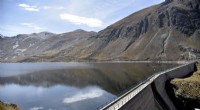 Smeltende snedæksler staver vandproblemer for verdens højeste hovedstadIncachaca -dæmningen, som leverer byen La Paz, Bolivia med vand, ses 12. september, 2019 Vandressourcerne løber tør i verdens højest beliggende hovedstad på grund af den kombinerede effekt af de a
Smeltende snedæksler staver vandproblemer for verdens højeste hovedstadIncachaca -dæmningen, som leverer byen La Paz, Bolivia med vand, ses 12. september, 2019 Vandressourcerne løber tør i verdens højest beliggende hovedstad på grund af den kombinerede effekt af de a -
 FN -ordninger for at redde skove kan trampe på stammers rettighederMange mennesker i Den Demokratiske Republik Congo er afhængige af hurtigt svindende skov til deres levebrød Den eneste FN-godkendte finansielle mekanisme til at dæmme op for skovrydning, en vigtig
FN -ordninger for at redde skove kan trampe på stammers rettighederMange mennesker i Den Demokratiske Republik Congo er afhængige af hurtigt svindende skov til deres levebrød Den eneste FN-godkendte finansielle mekanisme til at dæmme op for skovrydning, en vigtig -
 Jord kunne filtrere antibiotika fra renset spildevand, at beskytte grundvandetForsker Alison Franklin, en ph.d.-studerende ved Højskolen for Jordbrugsvidenskab, sætter hætten på en jordprøve taget fra Penn States Living Filter med en Giddings hydrauliske jordprøvetager. Hun led
Jord kunne filtrere antibiotika fra renset spildevand, at beskytte grundvandetForsker Alison Franklin, en ph.d.-studerende ved Højskolen for Jordbrugsvidenskab, sætter hætten på en jordprøve taget fra Penn States Living Filter med en Giddings hydrauliske jordprøvetager. Hun led -
 Grønlandssmeltning øges sandsynligvis af bakterier i sedimentEn supraglacial strøm og sedimentflodslette i det sydvestlige Grønland. Kredit:Sasha Leidman Bakterier udløser sandsynligvis større afsmeltning på Grønlands indlandsis, muligvis øge øens bidrag ti
Grønlandssmeltning øges sandsynligvis af bakterier i sedimentEn supraglacial strøm og sedimentflodslette i det sydvestlige Grønland. Kredit:Sasha Leidman Bakterier udløser sandsynligvis større afsmeltning på Grønlands indlandsis, muligvis øge øens bidrag ti
- Forskere udvikler kunstig intelligens til at forudsige startup-virksomheders succes
- At have ansatte i udlandet hjælper virksomheder med at høste amerikanske skattefordele
- Sådan ændres farven på Metal Surfaces
- Skovhøst i Europa truer klimamål:undersøgelse
- Forskere forklarer, hvordan wombats taber afføring i terninger
- Er der en sammenhæng mellem lykke og kulstofemissioner?


